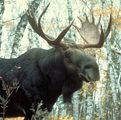Assessing Recent Biodiversity Response to Climate Change
 Integrating global species distributions, remote sensing information and climate station data to assess recent biodìversity response to climate change
Integrating global species distributions, remote sensing information and climate station data to assess recent biodìversity response to climate change
Thanks to remotely-sensed and ground-based climate observations society now has an extremely detailed understanding of the geography and magnitude of recent climate change. The detail and relative geographic evenness of this knowledge is in stark contrast to that of the spatial distribution of biodiversity and its changes over time. General, quantitative insights about biodiversity change have been limited by a lack of available longer-term data. Yet, to date, only a small and geographically very restricted portion of already collected biodiversity information has been empowered and utilized for global change research.
The objectives of this project are to link newly developed global environmental layers to all accessible biodiversity distribution data of the past 50 years that is spatially and temporally explicit, and for the most data-rich species perform a first assessment of the emerging signal of climate change-driven biodiversity change and how it relates to the network of protected areas and SIGEO sites. Specifically, the project sets out to:
- Develop select global environmental layers of high spatial and temporal resolution extending back to the 1960s (climate) and 1980s (derived from global satellite observations and model outputs) and of particular suitability for species distribution modeling. These layers will integrate remote-sensing information, ground-based observation and climate models;
- Perform a spatio-temporal join of this information with data currently or soon available at GBIF at the spatial and temporal accuracy specific to a record (ideally grains of kilometer and day or month). This will add a to date missing, yet extremely powerful additional knowledge dimension to biodiversity data; then select the most data-rich (in terms of spatial and temporal coverage) ca. 1,000 species and compare environmental vs. spatial associations between an earlier and more recent time period using a variety of niche modeling methods; This will allow identification of species and regions with strongest distribution response and its climatic underpinning.
- For these same species assess probabilistic occurrence and changes therein across SIGEO sites and protected areas in the US and worldwide.
In its objectives and scope the proposed work ties in and benefits strongly from existing efforts this research team is leading or involved in. Access, quality control and management of biodiversity data is facilitated by an EOL working group and a recently recommended NSF project Map of Life (PIs Jetz, Guralnick). The Map of Life project will build infrastructure for the integration of global species distribution data. Significant intellectual guidance for the development of global environmental layers for species distribution modeling will come from the NCEAS working group on Organisms and Environment (PIs McGill, Guralnick, Jetz, McPherson) which has this specific advisory role as its stated goal. The Ecological Forecasting Lab at NASA Ames led by Nemani is a member of this working group and has substantial expertise and computational resources for the calculation of detailed global layers, but neither NCEAS group nor Nemani lab currently have funds for layer development and modeling use.
The project offers tremendous synergies with these existing global biodiversity efforts and will add a vital environmental change and remote sensing dimension to them, thus strongly advancing the contribution of NASA to the biodiversity community. The project outcomes of environmental layers, enriched biodiversity information, probabilistic reserve species lists and biological change assessments will improve scientific knowledge and facilitate natural resource management in multiple significant ways.
UMaine Investigator: Brian McGill, School of Biology & Ecology & Senator George J. Mitchell Center
Sponsor: National Aeronautics and Space Administration (NASA) through Yale University
